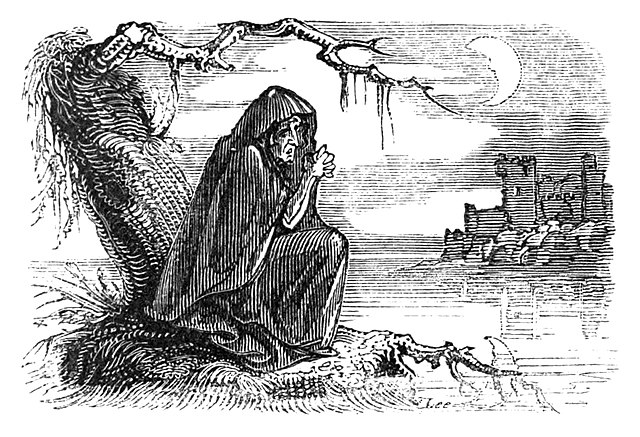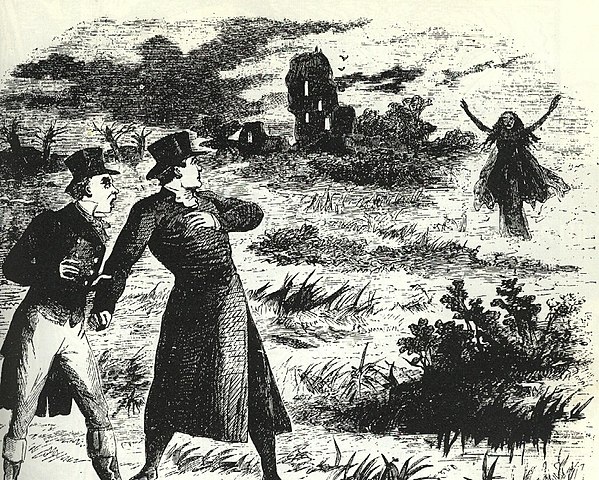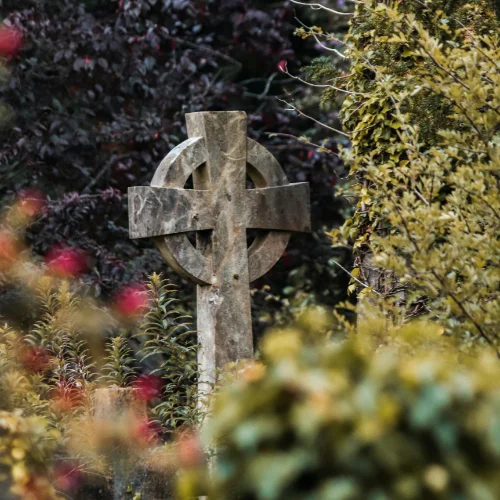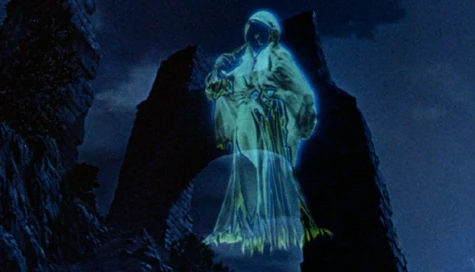Irish Myths Banshee: Ireland’s Mysterious Spirit
I remember walking along the streets of my hometown in Clonmel, Co. Tipperary, as a kid and seeing a comb on the ground. I remember bending down to pick it up only to hear my mam yell at me to leave it alone. “If you pick that up, the banshee will come visit you,” she said.
From that day forward, every time I come across a comb on the ground, it reminds me of this warning from my youth. It also made me love our Irish beliefs and how stories of mystical creatures in Ireland still have a hold on us.
Table of Contents
The Irish Banshee

Irish mythology is rich with legends, magical creatures, and mysterious beings that have shaped the country’s cultural identity for centuries. From heroic warriors to mischievous Irish fairies, these stories reflect Ireland’s deep connection to nature, the supernatural, and the human experience.
Among the most famous mythical figures is Ireland’s Banshee, a ghostly woman whose eerie presence is said to warn of death.
Known for her haunting cry, the Banshee has captured the imagination of many and continues to play a significant role in Irish folklore.
Let’s explore who Ireland’s Banshee is, where she comes from, and the chilling tales surrounding her.
What is a Banshee?
The word Banshee comes from the Irish term bean sí, which means “woman of the fairy mound.” In Irish mythology, a Banshee is a spirit or ghost believed to be a messenger of death. She doesn’t cause death but is thought to appear before a family member passes away, warning of the tragedy with her mournful cry or wail.
Ireland’s Banshee is often connected to old Irish families, and her appearance was considered a sign that someone close would soon die. In this way, she plays a significant role in mythology as a reminder of mortality and a connection to Ireland’s ancient beliefs in the supernatural.
Physically, the Banshee is said to take on different forms. Some legends describe her as an old woman with long, grey hair, wearing ragged clothes. Others say she appears as a young, beautiful woman with flowing red or silver hair.
No matter her form, she’s usually dressed in white or grey, and a chilling sense of sadness or dread always accompanies her presence. Her cry, often described as a high-pitched, wailing sound, is her most well-known feature—a sound that’s said to strike fear in those who hear it.
The Banshee’s Origins in Irish Mythology

Ireland’s Banshee’s origins can be traced back to Ireland’s ancient beliefs in the supernatural. Some people even believe she is connected to the Tuatha Dé Danann, a magical race of beings who played a crucial role in Irish mythology.
The Tuatha Dé Danann were considered gods and goddesses who ruled Ireland before being defeated and forced to live underground. Over time, they became associated with the fairy world, and the Banshee is sometimes thought to be one of these fairy spirits.
One of the most interesting aspects of Ireland’s Banshee legend is her connection to certain Irish families. Traditionally, it was believed that the Banshee would only appear to warn members of old, noble families, particularly those with surnames like O’Neill, O’Brien, O’Connor, O’Grady, and Kavanagh.
These families were often powerful and influential, so the Banshee’s appearance was seen as a grave and important omen.
In Celtic culture, the Banshee represents more than just a warning of death. She symbolizes the deep connection between the living and the spirit world. The Irish believed strongly in the afterlife, and the Banshee’s presence reminded them that death was a natural part of life’s cycle.
Her wail, or caoineadh (meaning “to keen”), mirrors the traditional practice of women mourning the dead at funerals in Ireland, blending the human and the supernatural to reflect the culture’s respect for the dead and the mysteries of the afterlife.
The Cry of the Banshee: Her Famous Wail
Ireland’s Banshee is most famous for her eerie, haunting cry, often called a wail or keening. This chilling sound is believed to be a warning that someone’s death is near.
The wail is usually described as high-pitched, almost like a scream, but filled with sadness. People who claim to have heard it say the sound can send shivers down your spine.
Interestingly, the sound of Ireland’s Banshee’s wail can differ depending on the region in Ireland. In some areas, she’s said to let out a loud, terrifying scream that echoes through the hills, while in others, her cry is more of a soft, mournful song or low moan. But no matter how it sounds, hearing the Banshee’s cry is always a sign of coming tragedy.
This wailing tradition may be connected to the ancient Irish custom of keening. In old Ireland, when someone died, women known as keeners would sing a mournful song at the person’s funeral.
Their wails were a way to express grief and send the soul to the afterlife. The Banshee’s cry is thought to be a supernatural version of this practice. Just like the keeners, she mourns the dead but appears before death happens, almost like a warning from the spirit world.
This connection between human mourners and the supernatural world is a vital part of Irish folklore, and it helps explain why Ireland’s Banshee legend has been passed down through the centuries. Her cry serves as both a reminder of loss and a symbol of the mystery surrounding life and death.
Banshee Sightings and Folklore

Over the centuries, there have been many Folklore tales of Banshee sightings across Ireland, each adding to her mysterious reputation. These stories are often passed down through generations, and while the details may vary, they all share the same theme: the Banshee’s appearance as a warning of death.
One famous tale comes from County Cork, where a local family claimed to hear the Banshee’s cry every time a family member was about to pass away. In another story from Limerick, a woman described seeing a Banshee in the form of a beautiful young girl combing her long hair by a stream.
The next day, someone in her family died suddenly, and the woman believed the Banshee’s appearance had been a sign.
There are also stories of people encountering the Banshee in different forms. Some say she appears as an old woman dressed in ragged clothes, while others describe her as a pale, ghostly figure with flowing hair. In each case, her presence brings an overwhelming sense of sadness or fear, and her wail is said to be impossible to forget.
But what exactly is the Banshee? Is she a bringer of death, or is she simply a warning? Most folklore suggests that the Banshee doesn’t cause death but acts as a messenger from the spirit world. She is not malevolent, and she doesn’t harm people.
Instead, she appears to prepare families for losing a loved one. Her role is often seen as compassionate as if she’s grieving alongside the family and helping them come to terms with their fate.
In some tales, the Banshee’s presence is considered protective, especially for noble families. She’s almost like a family guardian, offering a final, sorrowful farewell before death takes someone away. In this way, the Banshee is not something to fear but a reminder of the natural cycle of life and death.
The Banshee in Modern Culture

Even today, the legend of the Banshee still holds a special place in Irish culture. While we may no longer see her as a literal harbinger of death, the Banshee continues to symbolize mystery, fear, and our fascination with the supernatural. Her presence in Irish folklore reminds us of our connection to the past and the stories that shaped the identity of the Irish people.
The Banshee has also found her way into popular media, appearing worldwide in books, movies, and T.V. shows. She’s often portrayed in literature as a tragic figure, such as in Celtic Myths and Legends, where she is seen as a mourning spirit.
In films like Darby O’Gill and the Little People (1959), the Banshee is depicted as a ghostly figure that terrifies those who see her, reflecting the traditional fear she inspires in Irish folklore.
More recently, she has appeared in T.V. series like Supernatural and video games like Assassin’s Creed: Valhalla, where her legend is reimagined to suit modern storytelling.
In modern Irish culture, the Banshee has come to symbolize more than just a warning of death. She represents the unknown, the mystery of what lies beyond life, and our natural fear of mortality.
Some view her as a symbol of grief and loss, reflecting the emotions we feel when faced with death. In this way, the Banshee reminds us of the human experience—how we cope with death, remember the ones we’ve lost, and find meaning in the stories that help us understand life’s darker moments.
Despite living in an age of technology and science, the Banshee continues to captivate the imagination, bridging the ancient world of folklore and the modern fascination with the supernatural.
Whether she’s seen as a ghost, a symbol of death, or a part of Irish cultural identity, the Banshee’s legend lives on.
Family Names Tied to the Banshee Legend
The O’Brien Banshee
The Banshee is often said to be tied to the O’Brien family, one of Ireland’s oldest noble families. In one famous tale, when King Brian Boru, the High King of Ireland, was preparing for the Battle of Clontarf in 1014, it was said that a Banshee appeared, warning him of his impending death.
Brian Boru was killed in battle despite leading his forces to victory, supposedly as the Banshee had foretold. The legend holds that the Banshee had forewarned of the death of a great Irish king.
The Banshee of the O’Neills
The O’Neill family of Ulster has its own association with a Banshee. One of the most famous stories involves Sir Hugh O’Neill, who was warned by the Banshee about a tragic event.
Before one of his battles, it was said that Banshee’s mournful cry echoed through the family home, signalling the loss of many lives on the battlefield. Legend suggests that the Banshee appears to the O’Neill family before the death of any significant family member.
The Bunworth Banshee
This story dates to the 18th century and revolves around the Reverend Charles Bunworth, a well-respected clergyman and harpist in County Cork. Before his death, several people reported hearing the Banshee wailing near his home.
A close family friend, hearing the eerie cries, even tried to protect Bunworth by guarding him in the days leading up to his death. However, the Banshee’s cries continued, and Bunworth died shortly after. It’s said that the Banshee’s wail was heard by many mourners at his funeral.
The McCarthy Banshee
Another famous tale involves the McCarthy family of Cork. In this story, the Banshee is believed to have made her presence known before the death of a family member, crying out at a family gathering.
Many McCarthy family members have reported sightings or hearing the Banshee’s cry before a relative’s passing. This family’s Banshee is said to appear as a pale, beautiful woman dressed in white, her lengthy hair streaming in the wind.
The Rossmore Banshee
Lord Rossmore, who lived in County Monaghan, was warned by a Banshee of his death in the early 19th century. According to the story, one night, Lord Rossmore heard the wailing of the Banshee outside his home. Startled, he sent his servant to investigate, but nothing was found.
That same night, Lord Rossmore suddenly died in his sleep. The mysterious cries of the Banshee were believed to have foretold his unexpected death.
Further Reading:
Related Articles:
Books
“Celtic Myths and Legends” by T.W. Rolleston
This classic book explores many Celtic myths and legends, including the Banshee. It provides an in-depth look at Irish folklore and the supernatural beings that are part of the culture, making it a great starting point for anyone interested in the Banshee’s place in Irish mythology.
“The Banshee: The Irish Death Messenger” by Patricia Lysaght
This book is a detailed study of the Banshee legend, exploring its origins, variations, and impact on Irish culture. Patricia Lysaght delves into historical accounts and folklore, offering insights into the Banshee’s role as a symbol of death in Ireland.
“Fairy and Folk Tales of the Irish Peasantry” by W.B. Yeats
Compiled by the famous Irish poet and folklorist W.B. Yeats, this collection includes stories of fairies, banshees, and other supernatural beings. The book is a beautiful introduction to Irish folk tales, giving readers a sense of the Banshee’s presence in traditional stories.
“The Banshee” by Elliott O’Donnell
Written by an Irish author and ghost hunter, this book is a collection of stories and essays about the Banshee and other supernatural entities. O’Donnell explores the Banshee’s role as a death omen and shares various tales of sightings and encounters.
“Myths and Folk Tales of Ireland” by Jeremiah Curtin
Another excellent collection of Irish folklore, this book offers a variety of stories about fairies, spirits, and the Banshee. It’s an excellent resource for understanding how these legends have been passed down through generations.
